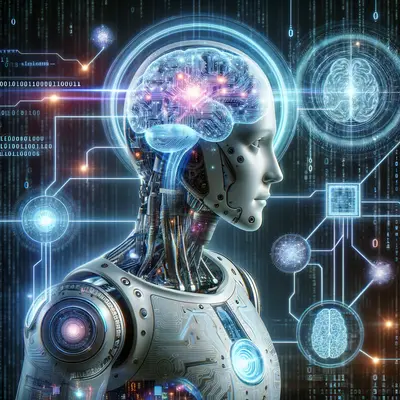The world is undergoing rapid technological changes, and education is no exception. Two of the most significant developments in the realm of education are online learning and artificial intelligence (AI). These innovations have transformed how students learn, teachers teach, and institutions deliver knowledge. In this article, we will explore how online learning and AI are reshaping education, the benefits and challenges associated with these technologies, and how they can complement each other to create a more effective and accessible educational experience.
What is Online Learning?
Online learning, also known as e-learning, is a method of education that takes place over the internet. Instead of attending traditional face-to-face classes in a physical location, students can access educational materials, participate in discussions, and complete assignments online. The rise of online learning has been fueled by the development of the internet, mobile devices, and various digital platforms that make it easier for students to learn at their own pace, in their own time.

Online learning can take many forms, including:
1. Self-paced learning: Students can access materials and work through them at their own speed.
2. Instructor-led courses: These courses are guided by teachers or instructors who provide feedback, support, and structure, much like traditional classrooms.
3. Hybrid learning: This model blends online education with face-to-face instruction, offering students the flexibility of online learning while maintaining some personal interaction.
What is Artificial Intelligence?
Artificial intelligence (AI) refers to the development of computer systems that can perform tasks usually requiring human intelligence. These tasks include problem-solving, learning from experience, understanding language, recognizing patterns, and even making decisions. AI has a broad range of applications, from robotics to medical diagnoses, but one of its most exciting uses is in education.
AI in education involves the use of machine learning algorithms, natural language processing, and other AI technologies to improve learning experiences, automate tasks, and provide personalized feedback. For example, AI can help identify areas where students are struggling and suggest tailored learning materials to help them improve.
How Online Learning and AI Work Together
The combination of online learning and AI has the potential to revolutionize education. By integrating AI into online learning platforms, educators can offer a more personalized, efficient, and engaging learning experience for students. Here’s how these two technologies complement each other:
1. Personalized Learning: AI can analyze a student’s learning behavior, track their progress, and identify their strengths and weaknesses. Based on this data, AI-powered systems can recommend customized learning paths, offering students resources and exercises that target areas where they need the most help. This personalized approach can significantly improve student outcomes, as learners receive tailored support rather than a one-size-fits-all curriculum.
2. Automated Grading and Feedback: One of the biggest challenges for educators is grading assignments and providing timely feedback to students. AI can automate these tasks, allowing teachers to focus on more important aspects of instruction. AI-powered systems can grade multiple-choice quizzes, short answers, and even essays. Moreover, these systems can provide immediate feedback to students, helping them understand their mistakes and learn more effectively.
3. Adaptive Learning: Adaptive learning is an AI-driven technique that adjusts the difficulty and content of lessons based on a student’s performance. For example, if a student is struggling with a specific concept, the AI system can present additional explanations or practice questions until the student grasps the topic. On the other hand, if a student is excelling, the system can introduce more challenging materials to keep them engaged.
4. Virtual Tutors and Chatbots: AI-powered virtual tutors and chatbots are becoming increasingly common in online learning environments. These intelligent systems can answer student queries, provide explanations, and offer guidance 24/7. Virtual tutors can simulate the experience of having a personal tutor, helping students who may need extra support outside of regular class hours.
5. Content Creation and Curation: AI can assist educators in creating and curating content for online courses. By analyzing existing educational materials, AI can suggest relevant resources, videos, and articles to enhance the learning experience. Additionally, AI can generate quizzes, flashcards, and other learning aids based on the course content.
6. Data-Driven Insights for Educators: AI can collect and analyze large amounts of data on student performance, participation, and engagement. This data can provide valuable insights for educators, helping them understand which teaching methods are most effective and identify areas where students may need additional support. With these insights, educators can make data-driven decisions to improve their courses and enhance student learning.
Benefits of Online Learning and AI
The integration of online learning and AI offers numerous benefits for both students and educators. Some of the most notable advantages include:
1. Flexibility and Accessibility: Online learning provides students with the flexibility to learn at their own pace and on their own schedule. This is especially beneficial for those who have other commitments, such as work or family responsibilities. AI enhances this experience by offering personalized learning paths, ensuring that students receive the support they need, regardless of their location or time zone.
2. Cost-Effective Education: Traditional education can be expensive, with costs associated with tuition, transportation, and textbooks. Online learning can significantly reduce these expenses, making education more affordable. Additionally, AI-powered systems can automate tasks like grading and content creation, reducing the workload for educators and potentially lowering the cost of delivering education.
3. Increased Engagement: Online learning platforms often include interactive elements such as quizzes, videos, and discussions, which can keep students engaged. AI can further enhance engagement by adapting the learning experience to each student’s preferences and needs. For example, if a student learns better through videos, the AI system can recommend more video-based resources.
4. Scalability: Online learning and AI allow educational institutions to scale their offerings to reach a global audience. With AI-powered systems handling tasks like grading and content delivery, educators can focus on providing high-quality instruction to a larger number of students without being overwhelmed by administrative tasks.
5. Lifelong Learning: The flexibility and accessibility of online learning, combined with the personalized nature of AI, make it easier for individuals to pursue lifelong learning. Whether someone wants to acquire new skills for career advancement or simply learn for personal enrichment, online learning platforms powered by AI can provide the necessary resources and support.

Challenges of Online Learning and AI
While online learning and AI offer many benefits, they also present several challenges that need to be addressed:
1. Digital Divide: Not everyone has access to the internet or the necessary devices to participate in online learning. This digital divide can exacerbate educational inequalities, particularly in underserved communities. Ensuring that all students have access to the tools they need for online learning is crucial to bridging this gap.
2. Data Privacy and Security: AI systems rely on collecting and analyzing large amounts of data, including personal information about students. This raises concerns about data privacy and security. Educational institutions must implement strict data protection policies and ensure that AI systems are secure from potential breaches.
3. Lack of Human Interaction: One of the criticisms of online learning is the lack of face-to-face interaction between students and teachers. While AI can provide personalized feedback and virtual tutoring, it cannot fully replace the benefits of human interaction, such as emotional support and mentorship. Hybrid learning models, which combine online learning with in-person instruction, may help address this issue.
4. Dependence on Technology: As online learning and AI become more prevalent, there is a risk of over-reliance on technology. Technical issues, such as software glitches or internet outages, can disrupt learning. It’s essential for students and educators to have backup plans in place and not rely solely on digital tools.
5. Ethical Concerns: The use of AI in education raises ethical questions, particularly regarding bias and fairness. AI systems are only as good as the data they are trained on, and if that data is biased, the AI may perpetuate those biases in its recommendations and decisions. Educators must be aware of these potential issues and work to ensure that AI is used responsibly and fairly.
The Future of Online Learning and AI
As technology continues to evolve, the role of online learning and AI in education will only grow. In the future, we can expect even more sophisticated AI systems that provide personalized, adaptive learning experiences tailored to each student’s unique needs. Virtual reality (VR) and augmented reality (AR) may also become more integrated into online learning, offering immersive educational experiences that simulate real-world environments.
Moreover, AI-powered analytics will continue to provide educators with valuable insights, helping them refine their teaching methods and improve student outcomes. Online learning platforms will become more intuitive, offering seamless integration of AI-driven tools that enhance both teaching and learning.
Conclusion
Online learning and artificial intelligence are transforming education, making it more accessible, personalized, and efficient. While there are challenges to overcome, the potential benefits of these technologies are enormous. By leveraging the power of AI, educators can create engaging, effective learning experiences that meet the needs of students in the digital age. As we move forward, the integration of online learning and AI will continue to shape the future of education, opening up new opportunities for students and teachers alike.












Phenomenal writing! The way Dinosaur Game bridges generations of gamers is remarkable.